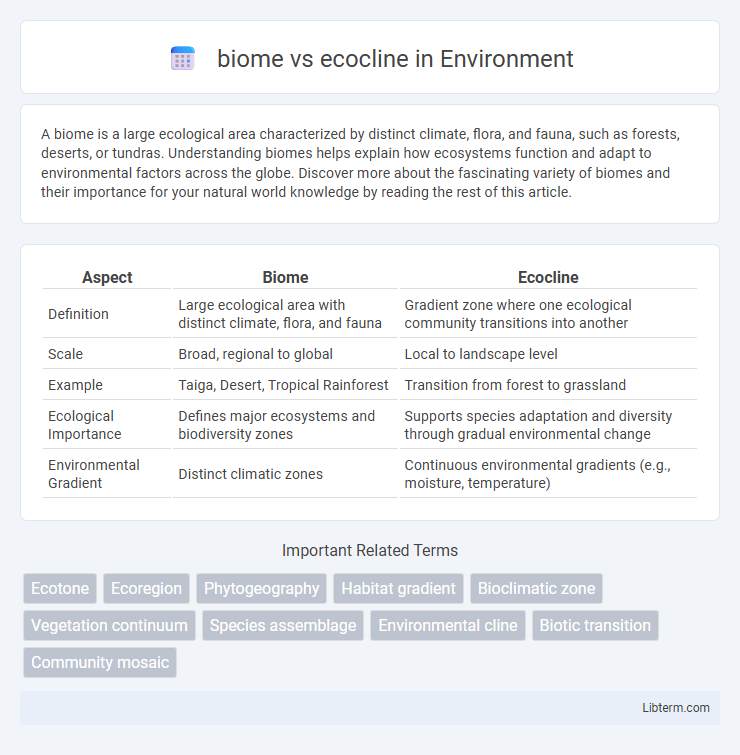A biome is a large ecological area characterized by distinct climate, flora, and fauna, such as forests, deserts, or tundras. Understanding biomes helps explain how ecosystems function and adapt to environmental factors across the globe. Discover more about the fascinating variety of biomes and their importance for your natural world knowledge by reading the rest of this article.
Table of Comparison
| Aspect | Biome | Ecocline |
|---|---|---|
| Definition | Large ecological area with distinct climate, flora, and fauna | Gradient zone where one ecological community transitions into another |
| Scale | Broad, regional to global | Local to landscape level |
| Example | Taiga, Desert, Tropical Rainforest | Transition from forest to grassland |
| Ecological Importance | Defines major ecosystems and biodiversity zones | Supports species adaptation and diversity through gradual environmental change |
| Environmental Gradient | Distinct climatic zones | Continuous environmental gradients (e.g., moisture, temperature) |
Introduction to Biomes and Ecoclines
Biomes are large ecological areas on Earth's surface characterized by distinct climate conditions, plant communities, and animal species, such as tropical rainforests, deserts, and tundras. Ecoclines represent gradual transition zones between two ecological communities or biomes, where environmental factors such as temperature, moisture, or soil composition shift, influencing species distribution. Understanding biomes and ecoclines is essential for studying ecosystem dynamics, biodiversity patterns, and environmental gradients.
Defining Biomes: Key Characteristics
Biomes are large ecological areas on the Earth's surface with distinct climate, flora, and fauna, characterized primarily by vegetation type and adapted organisms. Key characteristics of biomes include temperature range, precipitation patterns, dominant plant species, and soil types that influence species composition and ecosystem processes. In contrast, an ecocline represents a gradual transition in environmental conditions and species over a geographic gradient, highlighting continuous ecological variation rather than discrete community boundaries.
What is an Ecocline? Essential Features
An ecocline is a gradual transition zone between two distinct ecological communities or biomes, characterized by a continuous change in environmental conditions such as temperature, moisture, or soil composition. This gradient results in a diverse array of species adapted to intermediate conditions, reflecting the shifting balance of biotic and abiotic factors. Unlike a sharply defined biome boundary, ecoclines illustrate the dynamic and fluid nature of ecological distributions influenced by climatic and geographic variables.
Biomes vs Ecoclines: Core Differences
Biomes are large ecological areas characterized by distinct plant and animal communities adapted to specific climatic conditions, while ecoclines represent gradual transitions between adjacent ecosystems or biomes where environmental gradients create varying species compositions. The core difference lies in scale and boundary definition: biomes have relatively stable and broad geographic boundaries defined by climatic factors, whereas ecoclines display continuous variation without sharp borders, reflecting a spectrum of ecological change. Understanding these distinctions is crucial for ecological classification, conservation strategies, and studying species adaptation across environmental gradients.
Ecological Functions of Biomes
Biomes serve critical ecological functions by regulating climate, supporting biodiversity, and maintaining nutrient cycles across vast geographic regions characterized by distinct vegetation and climate patterns. They act as carbon sinks, influence hydrological cycles, and provide habitat for specialized flora and fauna, ensuring ecosystem stability and resilience. Unlike ecoclines, which represent gradual environmental gradients and species shifts within smaller areas, biomes function as broad ecological units essential for sustaining global ecological balance.
The Role of Ecoclines in Environmental Gradients
Ecoclines represent transitional zones where environmental gradients create shifts in species composition and ecosystem properties, offering a nuanced understanding of biodiversity changes over short spatial scales. These gradients often result from variations in factors such as temperature, moisture, or soil chemistry, facilitating adaptive responses and species interactions that differ from the more extensive and stable conditions defining biomes. Ecoclines serve as critical indicators for studying climate change impacts and habitat fragmentation, highlighting ecological processes at the interface of broader biome classifications.
Examples of Major Biomes Around the World
Major biomes around the world include the Amazon Rainforest, a tropical rainforest biome known for its high biodiversity and dense vegetation, and the Sahara Desert, characterized by arid conditions and sparse plant life. Ecoclines, such as the transition zone from the temperate deciduous forest to the boreal forest in North America, represent gradual environmental gradients where species composition changes continuously. These examples highlight how biomes represent distinct ecological regions while ecoclines illustrate the blending of ecosystems across geographic areas.
Real-World Ecocline Case Studies
Real-world ecocline case studies reveal gradual transitions between biomes, such as the shift from temperate forests to grasslands in the Great Plains of North America, where species composition and environmental factors change progressively over distance. In the Amazon Basin, ecoclines manifest as moisture gradients influencing the distribution of rainforest and savanna species along rainfall zones. These ecoclines demonstrate how subtle environmental variations drive biodiversity patterns and ecosystem functioning without distinct biome boundaries.
Importance of Understanding Biomes and Ecoclines in Ecology
Understanding biomes and ecoclines is crucial for ecological research because biomes represent large-scale ecosystems defined by climate and dominant vegetation, while ecoclines describe gradual transitions between ecological communities. Recognizing these distinctions helps predict species distribution, ecosystem responses to environmental gradients, and biodiversity patterns. Accurate knowledge of biomes and ecoclines informs conservation strategies and guides habitat management under changing climatic conditions.
Conclusion: Integrating Biomes and Ecoclines for Better Environmental Management
Integrating biomes and ecoclines enhances environmental management by providing a comprehensive framework to understand ecosystem variability and species adaptations across spatial gradients. Biomes classify large-scale ecological regions based on climate and vegetation, while ecoclines highlight continuous environmental changes influencing biodiversity within these biomes. Combining these concepts allows for more precise conservation strategies, sustainable resource allocation, and adaptive responses to climate change impacts.
biome Infographic

 libterm.com
libterm.com